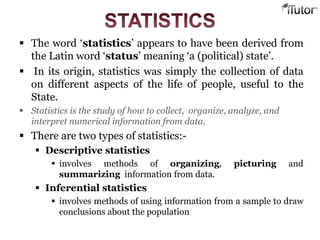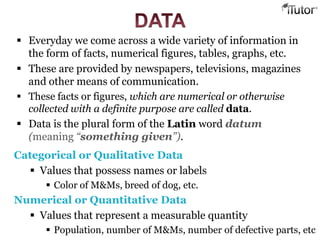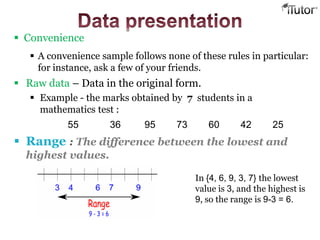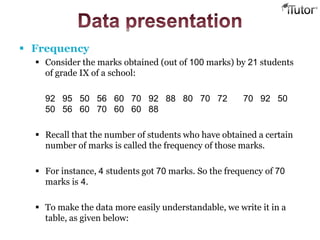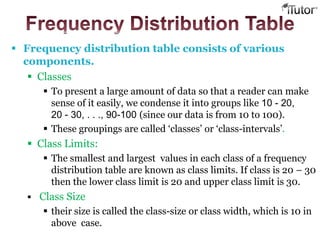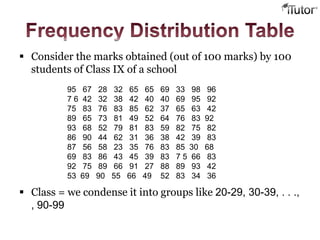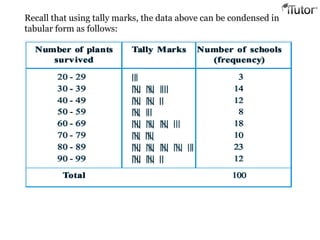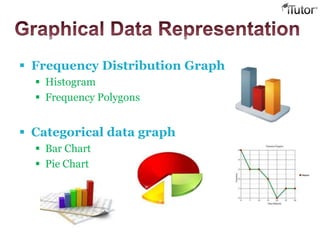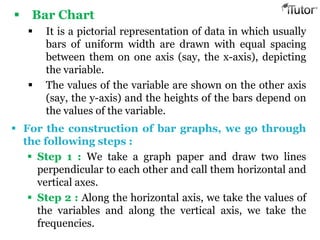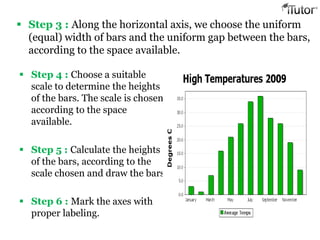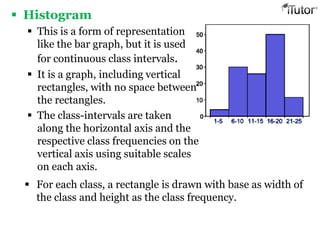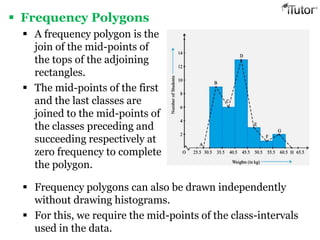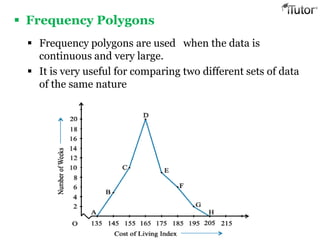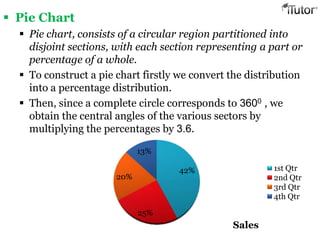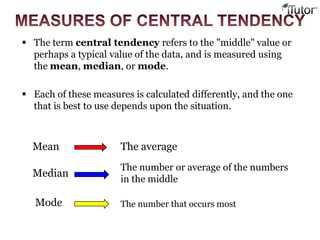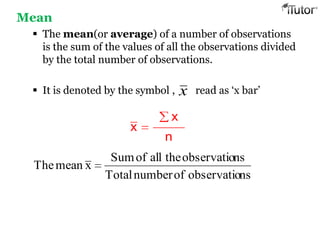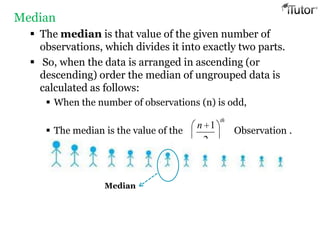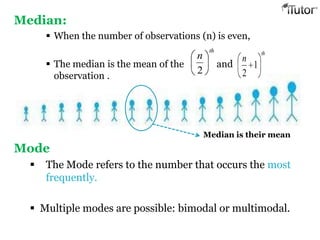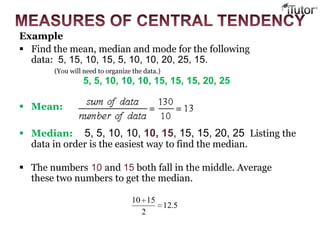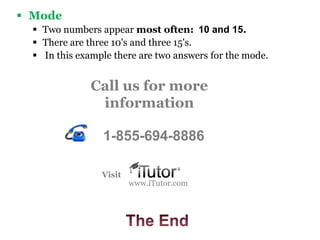Statistics
- 1. T- 1-855-694-8886 Email- info@iTutor.com By iTutor.com
- 2. The word ‘statistics’ appears to have been derived from the Latin word ‘status’ meaning ‘a (political) state’. In its origin, statistics was simply the collection of data on different aspects of the life of people, useful to the State. Statistics is the study of how to collect, organize, analyze, and interpret numerical information from data. There are two types of statistics:- Descriptive statistics involves methods of organizing, picturing and summarizing information from data. Inferential statistics involves methods of using information from a sample to draw conclusions about the population
- 3. Everyday we come across a wide variety of information in the form of facts, numerical figures, tables, graphs, etc. These are provided by newspapers, televisions, magazines and other means of communication. These facts or figures, which are numerical or otherwise collected with a definite purpose are called data. Data is the plural form of the Latin word datum (meaning “something given”). Categorical or Qualitative Data Values that possess names or labels Color of M&Ms, breed of dog, etc. Numerical or Quantitative Data Values that represent a measurable quantity Population, number of M&Ms, number of defective parts, etc
- 4. Sampling Random Involves choosing individuals completely at random from a population- for instance putting each student’s name in a hat and drawing one at random. Systematic involve selecting individuals at regular intervals. For instance, choose every 4th name on the roll sheet for your class. Stratified Stratified sampling makes sure you’re equally representing certain subgroups: for instance, randomly choose 2 males and 2 females in your class . Cluster Cluster sampling involves picking a few areas and sampling everyone in those areas. For instance, sample everyone in the first row and everyone in the third row, but no one else.
- 5. Raw data – Data in the original form. Example - the marks obtained by 7 students in a mathematics test : 55 36 95 73 60 42 25 Range : The difference between the lowest and highest values. In {4, 6, 9, 3, 7} the lowest value is 3, and the highest is 9, so the range is 9-3 = 6. Convenience A convenience sample follows none of these rules in particular: for instance, ask a few of your friends.
- 6. Frequency Consider the marks obtained (out of 100 marks) by 21 students of grade IX of a school: 92 95 50 56 60 70 92 88 80 70 72 70 92 50 50 56 60 70 60 60 88 Recall that the number of students who have obtained a certain number of marks is called the frequency of those marks. For instance, 4 students got 70 marks. So the frequency of 70 marks is 4. To make the data more easily understandable, we write it in a table, as given below:
- 7. Marks Number of students (i.e., the frequency) 50 3 56 2 60 4 70 4 72 1 80 1 88 2 92 3 95 1 Total 21 Table is called an ungrouped frequency distribution table, or simply a frequency distribution table
- 8. Frequency distribution table consists of various components. Classes To present a large amount of data so that a reader can make sense of it easily, we condense it into groups like 10 - 20, 20 - 30, . . ., 90-100 (since our data is from 10 to 100). These groupings are called ‘classes’ or ‘class-intervals’. Class Limits: The smallest and largest values in each class of a frequency distribution table are known as class limits. If class is 20 – 30 then the lower class limit is 20 and upper class limit is 30. Class Size their size is called the class-size or class width, which is 10 in above case.
- 9. Class limit Middle value of class interval also called Mid value. If the class is 10 – 20 then class limit Class frequency: The number of observation falling within a class interval is called class frequency of that class interval. 2 limlim itHigheritLower 15 2 2010
- 10. Consider the marks obtained (out of 100 marks) by 100 students of Class IX of a school Class = we condense it into groups like 20-29, 30-39, . . ., , 90-99 95 67 28 32 65 65 69 33 98 96 7 6 42 32 38 42 40 40 69 95 92 75 83 76 83 85 62 37 65 63 42 89 65 73 81 49 52 64 76 83 92 93 68 52 79 81 83 59 82 75 82 86 90 44 62 31 36 38 42 39 83 87 56 58 23 35 76 83 85 30 68 69 83 86 43 45 39 83 7 5 66 83 92 75 89 66 91 27 88 89 93 42 53 69 90 55 66 49 52 83 34 36
- 11. Recall that using tally marks, the data above can be condensed in tabular form as follows:
- 12. Frequency Distribution Graph Histogram Frequency Polygons Categorical data graph Bar Chart Pie Chart
- 13. Bar Chart It is a pictorial representation of data in which usually bars of uniform width are drawn with equal spacing between them on one axis (say, the x-axis), depicting the variable. The values of the variable are shown on the other axis (say, the y-axis) and the heights of the bars depend on the values of the variable. For the construction of bar graphs, we go through the following steps : Step 1 : We take a graph paper and draw two lines perpendicular to each other and call them horizontal and vertical axes. Step 2 : Along the horizontal axis, we take the values of the variables and along the vertical axis, we take the frequencies.
- 14. Step 4 : Choose a suitable scale to determine the heights of the bars. The scale is chosen according to the space available. Step 5 : Calculate the heights of the bars, according to the scale chosen and draw the bars. Step 6 : Mark the axes with proper labeling. Step 3 : Along the horizontal axis, we choose the uniform (equal) width of bars and the uniform gap between the bars, according to the space available.
- 15. Histogram This is a form of representation like the bar graph, but it is used for continuous class intervals. It is a graph, including vertical rectangles, with no space between the rectangles. The class-intervals are taken along the horizontal axis and the respective class frequencies on the vertical axis using suitable scales on each axis. For each class, a rectangle is drawn with base as width of the class and height as the class frequency.
- 16. Frequency Polygons A frequency polygon is the join of the mid-points of the tops of the adjoining rectangles. The mid-points of the first and the last classes are joined to the mid-points of the classes preceding and succeeding respectively at zero frequency to complete the polygon. Frequency polygons can also be drawn independently without drawing histograms. For this, we require the mid-points of the class-intervals used in the data.
- 17. Frequency Polygons Frequency polygons are used when the data is continuous and very large. It is very useful for comparing two different sets of data of the same nature
- 18. Pie Chart Pie chart, consists of a circular region partitioned into disjoint sections, with each section representing a part or percentage of a whole. To construct a pie chart firstly we convert the distribution into a percentage distribution. Then, since a complete circle corresponds to 3600 , we obtain the central angles of the various sectors by multiplying the percentages by 3.6. 42% 25% 20% 13% Sales 1st Qtr 2nd Qtr 3rd Qtr 4th Qtr
- 19. The term central tendency refers to the "middle" value or perhaps a typical value of the data, and is measured using the mean, median, or mode. Each of these measures is calculated differently, and the one that is best to use depends upon the situation. Mean The average Median The number or average of the numbers in the middle Mode The number that occurs most
- 20. Mean The mean(or average) of a number of observations is the sum of the values of all the observations divided by the total number of observations. It is denoted by the symbol , read as ‘x bar’ x x n nsobservatioofnumberTotal nsobservatiotheallofSum xmeanThe x
- 21. Median The median is that value of the given number of observations, which divides it into exactly two parts. So, when the data is arranged in ascending (or descending) order the median of ungrouped data is calculated as follows: When the number of observations (n) is odd, The median is the value of the Observation . th n 2 1 Median
- 22. Median is their mean Median: When the number of observations (n) is even, The median is the mean of the and observation . th n 2 th n 1 2 Mode The Mode refers to the number that occurs the most frequently. Multiple modes are possible: bimodal or multimodal.
- 23. Example Find the mean, median and mode for the following data: 5, 15, 10, 15, 5, 10, 10, 20, 25, 15. (You will need to organize the data.) 5, 5, 10, 10, 10, 15, 15, 15, 20, 25 Mean: Median: 5, 5, 10, 10, 10, 15, 15, 15, 20, 25 Listing the data in order is the easiest way to find the median. The numbers 10 and 15 both fall in the middle. Average these two numbers to get the median. 5.12 2 1510
- 24. Mode Two numbers appear most often: 10 and 15. There are three 10's and three 15's. In this example there are two answers for the mode. Call us for more information www.iTutor.com 1-855-694-8886 Visit

